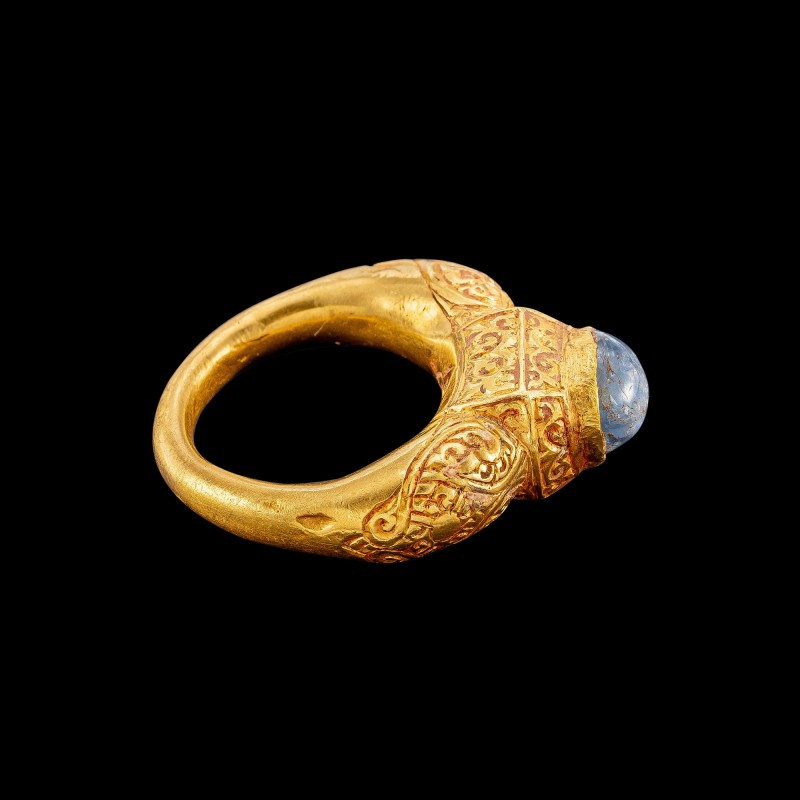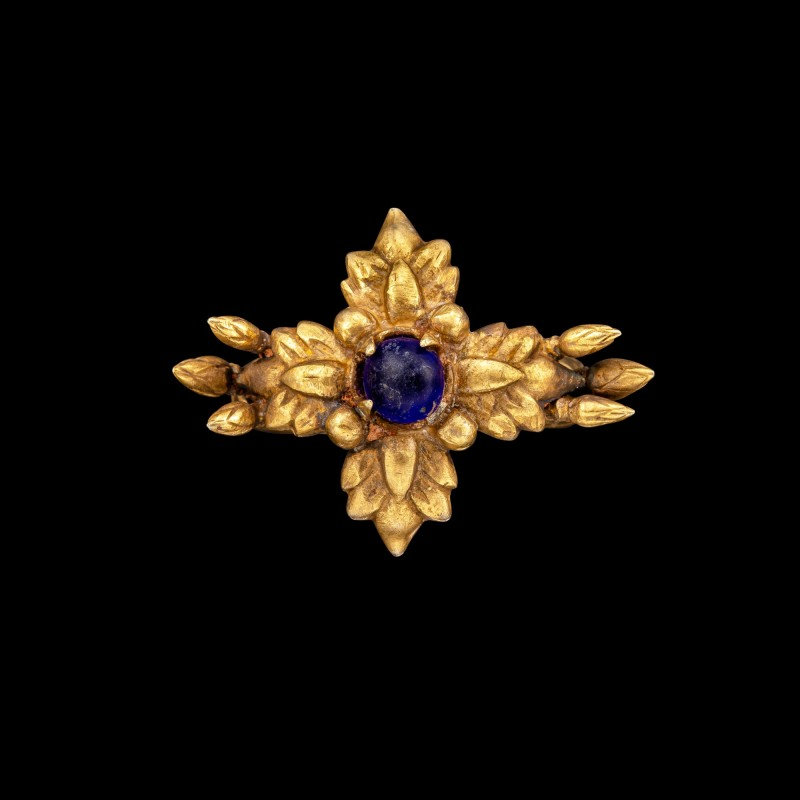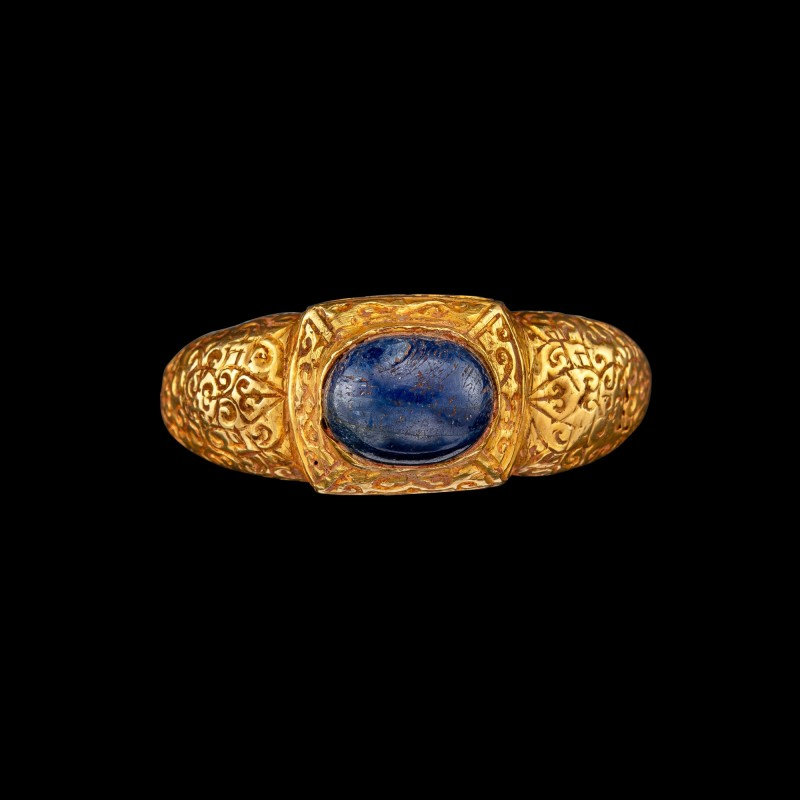Four gold and gem repoussé rings, Champa, 14th century
Lot 1022. A gold and cabochon star sapphire repoussé ring, Champa, 14th century; d. 2.2 cm; 18.9 grams. Estimate: 13,000 - 15,000 HKD. Lot sold: 35,280 HKD. Courtesy Sotheby's.
Property from the Tuyêt Nguyêt and Stephen Markbreiter Collection.
Literature: Susan Ollemans, 'Ancient Gold Rings from Asia. The Tuyet Nguyet Collection’, Arts of Asia, July-August 2017, pl. 21.
Lot 1048. A gold and blue-gem 'four-pointed lotus' ring, Possibly Champa, 14th century; d. 1.8 cm; 18.4 grams. Estimate: 9,000 - 12,000 HKD. Lot sold: 35,280 HKD. Courtesy Sotheby's.
Property from the Tuyêt Nguyêt and Stephen Markbreiter Collection.
Lot 1060. A gold and red-gem repoussé ring, Champa, 14th century; d. 2.2 cm; 21 grams. Estimate: 26,000 - 28,000 HKD. Lot sold: 277,200 HKD. Courtesy Sotheby's.
Property from the Tuyêt Nguyêt and Stephen Markbreiter Collection.
Literature: Susan Ollemans, 'Ancient Gold Rings from Asia. The Tuyet Nguyet Collection’, Arts of Asia, July-August 2017, pl. 23.
Lot 1073. A gold and cabochon sapphire repoussé ring, Champa, 14th century; d. 2 cm; 21.6 grams. Estimate: 26,000 - 28,000 HKD. Lot sold: 107,100 HKD. Courtesy Sotheby's.
Property from the Tuyêt Nguyêt and Stephen Markbreiter Collection.
Literature: Susan Ollemans, 'Ancient Gold Rings from Asia. The Tuyet Nguyet Collection’, Arts of Asia, July-August 2017, pl. 24.
Note: From the 2nd century through to the 15th century, the Champa Empire flourished in present-day central and southern Vietnam. As a result of the region being divided by numerous rivers and separated by mountains, Champa was not a unified kingdom but rather a coalition of polities whose power waxed and waned. The Champa empire borrowed heavily from Indian culture and religion, even adopting Sanskrit as its sacred language. In Sanskrit, Champa is the name of a bush and a flower.
Maritime trade was the primary source of income for the seafaring Cham; many also earned a living through farming, silk weaving, and gold jewellery crafting. From the 10th century onwards, Arab merchants stopped along the Vietnamese coast en route to China, bringing an increased Islamic cultural and religious influence.
As seen in this exquisite group of 14th-century Champa gold rings in the collection, each ring is set with a precious stone in a high collet, decorated with intricate repoussé work on the shanks and engraved with a four-petaled lotus motif on the reverse. Each piece shows considerable Arabic artisanal influence.
This group of gold jewellery remains as evidence of this once great civilization before its fall to northern Vietnamese invaders in the 15th century.
Sotheby's. Golden Splendour – Gold Jewellery from the Collection of Tuyet Nguyet and Stephen Markbreiter, Hong Kong, 28 July 2021

/https%3A%2F%2Fprofilepics.canalblog.com%2Fprofilepics%2F1%2F0%2F100183.jpg)
/https%3A%2F%2Fstorage.canalblog.com%2F03%2F02%2F119589%2F96711876_o.jpg)
/https%3A%2F%2Fstorage.canalblog.com%2F11%2F31%2F119589%2F94773502_o.jpg)
/https%3A%2F%2Fstorage.canalblog.com%2F20%2F83%2F119589%2F94772815_o.jpg)
/https%3A%2F%2Fstorage.canalblog.com%2F26%2F72%2F119589%2F75604929_o.jpg)
/https%3A%2F%2Fstorage.canalblog.com%2F59%2F60%2F119589%2F26458628_o.jpg)














/http%3A%2F%2Fstorage.canalblog.com%2F34%2F43%2F119589%2F129536359_o.jpg)
/http%3A%2F%2Fstorage.canalblog.com%2F76%2F30%2F119589%2F129536158_o.jpg)
/http%3A%2F%2Fstorage.canalblog.com%2F83%2F20%2F119589%2F129481662_o.jpg)
/http%3A%2F%2Fstorage.canalblog.com%2F16%2F82%2F119589%2F127928701_o.jpg)